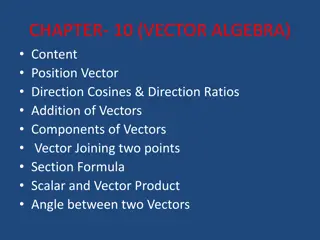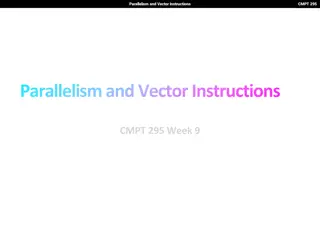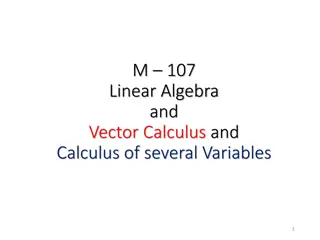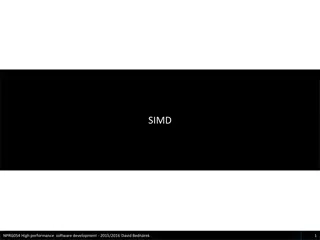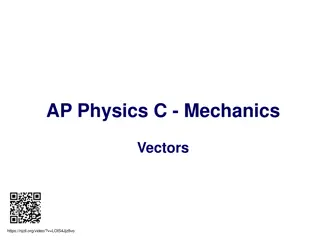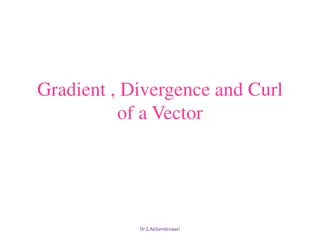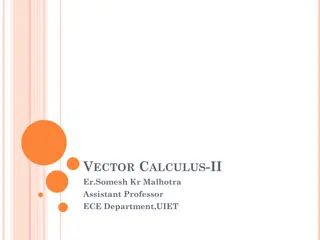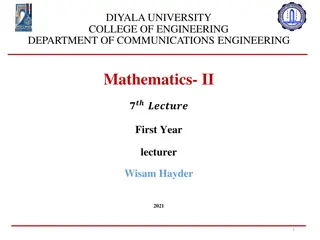
Understanding Vectors and Coordinate Systems in Mathematics
Explore the concepts of vectors, coordinate systems, and their conversions in mathematics. Learn about Cartesian and polar coordinates, vector notation, and the distinction between vectors and scalars.
Download Presentation

Please find below an Image/Link to download the presentation.
The content on the website is provided AS IS for your information and personal use only. It may not be sold, licensed, or shared on other websites without obtaining consent from the author. If you encounter any issues during the download, it is possible that the publisher has removed the file from their server.
You are allowed to download the files provided on this website for personal or commercial use, subject to the condition that they are used lawfully. All files are the property of their respective owners.
The content on the website is provided AS IS for your information and personal use only. It may not be sold, licensed, or shared on other websites without obtaining consent from the author.
E N D
Presentation Transcript
Chapter 3 Vectors
Coordinate Systems Used to describe the position of a point in space Coordinate system consists of a fixed reference point called the origin specific axes with scales and labels instructions on how to label a point relative to the origin and the axes
Cartesian Coordinate System Also called rectangular coordinate system x- and y- axes intersect at the origin Points are labeled (x,y)
Polar Coordinate System Origin and reference line are noted Point is distance r from the origin in the direction of angle , ccw from reference line Points are labeled (r, )
Polar to Cartesian Coordinates Based on forming a right triangle from r and x = r cos y = r sin
Cartesian to Polar Coordinates r is the hypotenuse and an angle y x + = tan = 2 2 r x y must be ccw from positive x axis for these equations to be valid
Example 3.1 The Cartesian coordinates of a point in the xy plane are (x,y) = (- 3.50, -2.50) m, as shown in the figure. Find the polar coordinates of this point. Solution: From Equation 3.4, = + = ( 3.50 m) ( 2.50 m) + = 2 2 2 2 4.30 m r x y and from Equation 3.3, y x = 2.50 m 3.50 m = = = tan 0.714 216
Vectors and Scalars A scalar quantity is completely specified by a single value with an appropriate unit and has no direction. A vector quantity is completely described by a number and appropriate units plus a direction.
Vector Notation When handwritten, use an arrow: When printed, will be in bold print: A When dealing with just the magnitude of a vector in print, an italic letter will be used: A or |A| The magnitude of the vector has physical units The magnitude of a vector is always a positive number A
Vector Example A particle travels from A to B along the path shown by the dotted red line This is the distance traveled and is a scalar The displacement is the solid line from A to B The displacement is independent of the path taken between the two points Displacement is a vector
Equality of Two Vectors Two vectors are equal if they have the same magnitude and the same direction A = B if A = B and they point along parallel lines All of the vectors shown are equal
Adding Vectors When adding vectors, their directions must be taken into account Units must be the same Graphical Methods Use scale drawings Algebraic Methods More convenient
Adding Vectors Graphically Choose a scale Draw the first vector with the appropriate length and in the direction specified, with respect to a coordinate system Draw the next vector with the appropriate length and in the direction specified, with respect to a coordinate system whose origin is the end of vector A and parallel to the coordinate system used for A
Adding Vectors Graphically, cont. Continue drawing the vectors tip-to-tail The resultant is drawn from the origin of A to the end of the last vector Measure the length of R and its angle Use the scale factor to convert length to actual magnitude
Adding Vectors Graphically, final When you have many vectors, just keep repeating the process until all are included The resultant is still drawn from the origin of the first vector to the end of the last vector
Adding Vectors, Rules When two vectors are added, the sum is independent of the order of the addition. This is the commutative law of addition A + B = B + A
Adding Vectors, Rules cont. When adding three or more vectors, their sum is independent of the way in which the individual vectors are grouped This is called the Associative Property of Addition (A + B) + C = A + (B + C)
Adding Vectors, Rules cont. When adding three or more vectors, their sum is independent of the way in which the individual vectors are grouped This is called the Associative Property of Addition (A + B) + C = A + (B + C)
Adding Vectors, Rules final When adding vectors, all of the vectors must have the same units All of the vectors must be of the same type of quantity For example, you cannot add a displacement to a velocity
Negative of a Vector The negative of a vector is defined as the vector that, when added to the original vector, gives a resultant of zero Represented as A A + (-A) = 0 The negative of the vector will have the same magnitude, but point in the opposite direction
Subtracting Vectors Special case of vector addition If A B, then use A+(- B) Continue with standard vector addition procedure
Multiplying or Dividing a Vector by a Scalar The result of the multiplication or division is a vector The magnitude of the vector is multiplied or divided by the scalar If the scalar is positive, the direction of the result is the same as of the original vector If the scalar is negative, the direction of the result is opposite that of the original vector
Components of a Vector A component is a part It is useful to use rectangular components These are the projections of the vector along the x- and y-axes
Vector Component Terminology Ax and Ayare the component vectors of A They are vectors and follow all the rules for vectors Axand Ayare scalars, and will be referred to as the components of A
Components of a Vector, 2 The x-component of a vector is the projection along the x-axis x A = cos A The y-component of a vector is the projection along the y-axis y A = sin A Then, = + A A A x y
Components of a Vector, 3 The y-component is moved to the end of the x-component This is due to the fact that any vector can be moved parallel to itself without being affected This completes the triangle
Components of a Vector, 4 The previous equations are valid only if is measured with respect to the x-axis The components are the legs of the right triangle whose hypotenuse is A A A = + = y 2 x 2 y 1 and tan A A A x May still have to find with respect to the positive x-axis
Components of a Vector, final The components can be positive or negative and will have the same units as the original vector The signs of the components will depend on the angle
Unit Vectors A unit vector is a dimensionless vector with a magnitude of exactly 1. Unit vectors are used to specify a direction and have no other physical significance
Unit Vectors, cont. The symbols , j , i k and represent unit vectors They form a set of mutually perpendicular vectors
Unit Vectors in Vector Notation i Axis the same as Ax andAyis the same as Ayetc. The complete vector can be expressed as x A = A i j j k + + A A y z
Adding Vectors Using Unit Vectors Using R = A + B Then ( ( R ) ( + i ) i j i j = + + + R A A B B x y x y ( ) ) j = = + + R A B A B x x y y + R R x y and so Rx= Ax+ Bxand Ry= Ay+ By R R = + = y 2 x 2 y 1 tan R R R x
Trig Function Warning The component equations (Ax= A cos and Ay= A sin ) apply only when the angle is measured with respect to the x-axis (preferably ccw from the positive x-axis). The resultant angle (tan = Ay/ Ax) gives the angle with respect to the x-axis. You can always think about the actual triangle being formed and what angle you know and apply the appropriate trig functions
Adding Vectors Using Unit Vectors Three Directions Using R = A + B ( ( R ) ( + ) k i j i j k k = + + + + + R A A A B B B x y z x y z ( ) ) ( ) i j = = + + + + R A B A B A B x x y y z z + + R R R x y z Rx= Ax+ Bx, Ry= Ay+ Byand Rz= Az+ Bz etc. = R R = + + 2 x 2 y 2 z 1 tan R R R R x x
Example 3.5: Taking a Hike A hiker begins a trip by first walking 25.0 km southeast from her car. She stops and sets up her tent for the night. On the second day, she walks 40.0 km in a direction 60.0 north of east, at which point she discovers a forest ranger s tower.
Example 3.5 (A) Determine the components of the hiker s displacement for each day. Solution: We conceptualize the problem by drawing a sketch as in the figure above. If we denote the displacement vectors on the first and second days by A and B respectively, and use the car as the origin of coordinates, we obtain the vectors shown in the figure. Drawing the resultant R, we can now categorize this problem as an addition of two vectors.
Example 3.5 We will analyze this problem by using our new knowledge of vector components. Displacement A has a magnitude of 25.0 km and is directed 45.0 below the positive x axis. From Equations 3.8 and 3.9, its components are: cos( 45.0 ) sin( 45.0 ) y A A = = = = (25.0 km)(0.707) = 17.7 km (25.0 km)( 0.707) A A x 17.7 km = The negative value of Ay indicates that the hiker walks in the negative y direction on the first day. The signs of Ax and Ay also are evident from the figure above.
Example 3.5 The second displacement B has a magnitude of 40.0 km and is 60.0 north of east. Its components are: cos60.0 sin60.0 y B B = = = = (40.0 km)(0.500) = 20.0 km (40.0 km)(0.866) B B x = 34.6 km
Problem Solving Strategy Adding Vectors Select a coordinate system Try to select a system that minimizes the number of components you need to deal with Draw a sketch of the vectors Label each vector
Problem Solving Strategy Adding Vectors, 2 Find the x and y components of each vector and the x and y components of the resultant vector Find z components if necessary Use the Pythagorean theorem to find the magnitude of the resultant and the tangent function to find the direction Other appropriate trig functions may be used
Q. Given the vectors A = 2.00 i + 6.00 j B = 3.00 i 2.00 j (a) draw the vector sum C = A + B and the vector difference D = A B. (b) Calculate C and D, first in terms of unit vectors and then in terms of polar coordinates, with angles measured with respect to the +x axis




